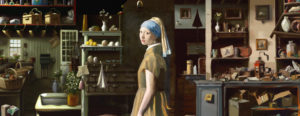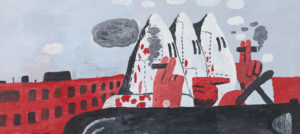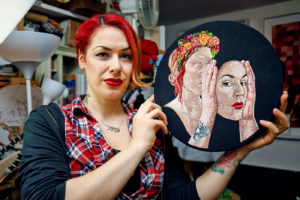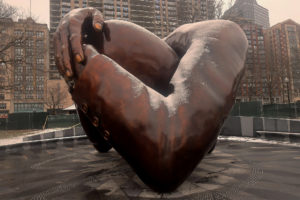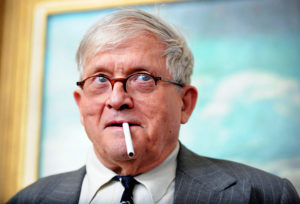This has been a long argument. In a few days, I will have lived for 77 years, and for nearly half that time, I have been challenging the National Gallery in London over one of its showpiece paintings.
At issue is the work presented to the public as the original Samson and Delilah, painted by Peter Paul Rubens in 1609. It was bought by the Gallery at a Christie’s auction in 1980 for £2.5 million: a modest sum now, but it was the most the Gallery had ever paid for a painting and a near record for any Old Master transaction.
I first saw it in 1986 and immediately felt it was a shoddy artefact, lacking the brilliance of my favourite European painter. Who am I — you ask — to judge? Well, I am an artist and art historian. My best-known expertise is the Greco-Roman funerary art of Egypt, and that in turn has led me to a broad study of colour and its application to surfaces ranging from marble to canvas, especially in the depiction of human figures. Now resident in my native Athens, I spent most of my working life in London.
When I came across the Gallery’s dubious acquisition, I was a mature student at Wimbledon School of Art, filling in some gaps in the education I had received at the Slade in London, the Cranbrook Academy in Michigan, and the Kokoschka School of Seeing in Salzburg. I was joined in my campaign by two fellow students half my age, Siân Hopkinson and Steve Harvey, who shared my intuition: this could not be a Rubens. As we researched, our doubts grew.
In 1992, the three of us submitted a report to the Gallery, full of naive enthusiasm. Although we know much more now, our report holds good: “The execution seemed crude, the colour unsubtle and uncharacteristic of Rubens’ palette. The tonal values were incorrect in relation to the light sources. The handling of the paint was very crude, the draughtsmanship was poor and there was weakness in the depiction of textures.”
Also, the provenance was suspect. Nobody doubts that Rubens depicted Samson and Delilah in a commission for Nicolaas Rockox, the mayor of Antwerp; or that the resulting work adorned the mayor’s salon until his death in 1640. During that time, two diligent copies of the painting were made: an engraving and an oil painting which shows the whole salon, including Rubens’ masterful work. Both copies survive and give an idea of the brilliance of the original. But after 1641, that original disappeared — and as we pointed out, the Gallery’s new acquisition differed significantly from the two careful copies which are the best guide to what Rubens produced.
As for the Gallery’s acquisition, the earliest sure fact was that in 1929, it was bought by German art dealers from a conservator in Paris; the seller seemingly made no claim that it was an original Rubens, but the German scholar Ludwig Burchard, a famous but flawed connoisseur, pronounced that it was the long-lost work of 1609. This verdict made a fortune for the German dealership, whose partners included Burchard’s brother Otto.
According to the National Gallery, the painting was held by the Royal House of Liechtenstein for two centuries; but the evidence for this, as the three of us determined, was flimsy. Our research was sound, but we were foolish to imagine we could penetrate a mighty fortress such as the National Gallery or indeed the Antwerp Rubenianum, a cliquey group of scholars which shows excessive deference to the opinions of Ludwig Burchard.
Still, arguments about the painting continued to flare, rising to a crescendo in 1996-97. Mike Daley, founder of Artwatch UK and a champion among cultural reporters, wrote incisive critiques, showing how the National Gallery’s Technical Bulletin of 1983, purporting to explain the painting’s physical structure and likely history, was odd and contradictory. At last, Neil MacGregor, director of the National Gallery, admitted that critics of the painting, who by that time included a fine Anglo-Polish scholar, Kasia Pisarek, might have a point. Pisarek at least has raised serious questions that “I cannot easily answer”, he told The Sunday Times. Meanwhile, the Gallery press office promised an open debate, which never happened.
Ever since, there have been surges of scepticism, which the Gallery has dismissed. In 2021, a high-tech company in Zurich, Art Recognition, used Artificial Intelligence to compare the brushstrokes in the contested work with scores of unchallenged works by Rubens; their verdict was that there was a 92% probability of it not being authentic. The Gallery simply said it would await fuller publication of the research.
Despite this Sphinx-like stance, I persist. And here, I want to disclose certain episodes of this story for the first time. First, an evening in April 1997. Sir Isaiah Berlin visited Athens to receive an honorary doctorate, and I attended a small dinner marking the occasion. The great Russo-British philosopher had served as a trustee of the National Gallery and knew its internal deliberations. I was excited. Also present was Marilena Cassimatis, an eminent Greek art historian.
When the issue of Rubens briefly surfaced over dinner, Berlin deftly changed topic. But afterwards, as we collected our coats, he approached Marilena and myself and uttered some unforgettable words: “I’ll help you with the Rubens. Write to [my fellow trustee] Sir Keith Thomas… tell him from me that the truth will come out in the end — it always does — and the sooner it comes out the better it will be.” Berlin then returned to his hotel in a taxi accompanied by Marilena and her husband. He and Marilena had bonded as German speakers.
“Your friend is right about the Rubens,” he said again. A few months later, Berlin died at 88. Shaken by his passing, I never contacted Thomas, who recently celebrated his 90th birthday. But the implications of Berlin’s words seem clear: did he think the Gallery knew things about the contested Rubens which it had not revealed? Had there been an internal debate about what to disclose, with Berlin advocating glasnost — unsuccessfully? Possibly sensing his mortality, had the philosopher broken the secrecy of the Gallery’s proceedings to give me a word of encouragement?
I salute his bravery. Meanwhile, a character in this saga who stands at the other end of the truth-telling spectrum is Brian Sewell, who before his death in 2015 was known as Britain’s cattiest and most influential art critic. Sewell always said he put friendship over truth or integrity; he had defiantly sheltered Anthony Blunt, the royal art adviser exposed as a traitor. When his friends in the National Gallery were challenged over the Rubens affair, Sewell responded with personal attacks on me and on Mike Daley. Having previously praised my work, he mocked me as an expert on “portraits on mummified corpses” and jibed: “there must surely be an old proverb warning us against unlikely Greeks expressing improbable opinions.” He went on to scorn Mike as a “dabbler in the dark”. When the full story of Samson and Delilah one day emerges, Sewell may be admired for his acerbic wit, but not as a friend of truth.
Another incident from that period spurs me on. It concerns the day — September 25, 1996 — when to shut me up, the Gallery asked me to its laboratory to watch as a dendrochronologist (a scientist who measures the age of wood) took a sample from the painting to assess its age. I had proposed such a test but for reasons I will explain, I do not believe that the experiment which happened was valid. In any case, something quite different jumped out at me as I saw the painting for the time without its frame.
I should first explain that one strange feature of the work is that it now rests on a cheap pink modern blockboard. In the Nineties, as Mike Daley and others rattled the Gallery’s cage, there was much contention over when the blockboard was added and why. Was it done to cover up, perhaps in more than one sense, the work’s origins? The Gallery adamantly insists that some time in the 20th century — well before its own purchase — the painting, originally on oak, “was planed down to a thickness of less than 3mm” and then stuck onto the blockboard. I have grave doubts over whether such a planing-down is physically possible.
What I saw in the laboratory that day was the familiar work, pasted on a tawdry pink blockboard, which to my surprise extended 10-14cms beyond the painting on all four sides, a feature which the frame, newly installed by the Gallery, had concealed. This protrusion was in stark contrast to the testimony I had gathered about the state of the painting before its arrival in London in 1980, when for several months it was mostly in the care of a Belgian bank. Before 1980 an older wooden backing, several centimetres thick, was intact, and above all the painting and its backing were co-extensive, nothing stuck out. So this much is clear: at some late stage in its chequered existence, the painting was tinkered with. The Gallery does not deny having put on a new frame, which was itself a deviation from conservation practice. I now ask: did it tinker with the painting in other ways, and if so, why?
To be clear, I don’t consider the Gallery’s Samson and Delilah a fake. It is a copy — made in good faith by a person who had studied one or both of the surviving reproductions of the Rubens original. I believe I know who made the copy.
Let’s start with some background. An unwritten law among artists is that if you copy an Old Master painting, you omit or alter one element, to show you are not aiming to deceive. This painting is a case in point. We also know that learning-through-copying was much practised in Madrid’s art school, the Academia Real de San Fernando in the 19th and early 20th centuries. Students produced hundreds of diligent but inexact copies, and Rubens was a popular prototype. I believe that the scrupulously inexact rendering of Samson and Delilah that now hangs in London is the work of one such Spanish-trained artist. And I think I have pinpointed exactly who that is.
It was Mike Daley who discovered a hand-written note by Ludwig Burchard in which he names — as Gaston Lévy — the Paris-based conservator who sold the contested painting to visiting German buyers in 1929. But which Gaston Lévy? The name is common. Tragically, my initial investigations revealed the details of at least 15 French Jews of that name who had perished in the Holocaust. Finally, thanks to the digitised archives of the Smithsonian Art Museum, I discovered a bearer of the name who fits perfectly into the story of this painting as I reconstruct it. Born in Brazil but educated in Madrid, he was a beloved pupil of the Spanish neo-impressionist Joaquín Sorolla y Bastida; he later moved to New York, where he spelt his surname Levi, and became a famous conservator.
I believe that this Gaston Lévy copied Samson and Delilah with the encouragement of his teacher. That helps explain why the palette and brushwork in the contested work are so close to Spanish neo-impressionism, and so far from 17th-century Flanders. I think I know too how Lévy worked. In Madrid in the early 20th century, he could never have found a vast oak panel. Budding artists made their copies on canvas. I believe the Gallery’s painting is on canvas, stretched over wood, and I challenge the Gallery’s current masters to prove me wrong.
Until that day comes, I have a working hypothesis as to how Lévy proceeded. When he moved to France in the Twenties, he simply rolled up the canvas in order to transport it. (Had his copy been on oak, it would have been difficult for a penurious artist to move.) On arrival in Paris, Lévy must have stuck the canvas onto six veneer-thin panels of oak, and then supported the whole structure by adding bits of thicker wood underneath. He put a trellis on the back to complete the look of a traditionally cradled painting, ready to be sold on the Paris market — not as an original Rubens but as a fine old work of art. Lévy’s elaborate backing was at some — rather late — stage replaced by the cheap blockboard. I ask the Gallery to tell us when and why.
My hunch that the Gallery’s painting is in fact executed on linen canvas, stuck on wood, has grown with every year since I saw it, unframed, in the laboratory. It looked excessively thin and somehow “ironed on”. Two eminent conservators recently told me, after seeing high-resolution images, that they too believe the painting to be on linen. Yet another clue is the Gallery’s own artless admission that when first inspected in its lab, the paint showed widespread “blistering”. That is exactly what you would expect if an oil-painted canvas was heat-sealed onto wood.
Of course, on that question, our hypothesis needs to be tested. With today’s technology, the Gallery could ascertain the exact material structure of the painting in a few minutes. Why won’t it do so? Could it be because that would risk exposing the dendrochronology test, on which the Gallery still relies, as irrelevant: if the painting was on canvas, the age of any underlying wood does not matter.
Honest investigation could embarrass some very grand personages. But to them, I simply repeat the words of Sir Isaiah Berlin: “The truth will come out in the end, and the sooner it does, the better it will be.” To the best of my ability, I have shared my thoughts about the story. I make no claim to omniscience. Will the other protagonists, who like me are in the evening of life, follow the great philosopher and share theirs?
Disclaimer
Some of the posts we share are controversial and we do not necessarily agree with them in the whole extend. Sometimes we agree with the content or part of it but we do not agree with the narration or language. Nevertheless we find them somehow interesting, valuable and/or informative or we share them, because we strongly believe in freedom of speech, free press and journalism. We strongly encourage you to have a critical approach to all the content, do your own research and analysis to build your own opinion.
We would be glad to have your feedback.
Source: UnHerd Read the original article here: https://unherd.com/

